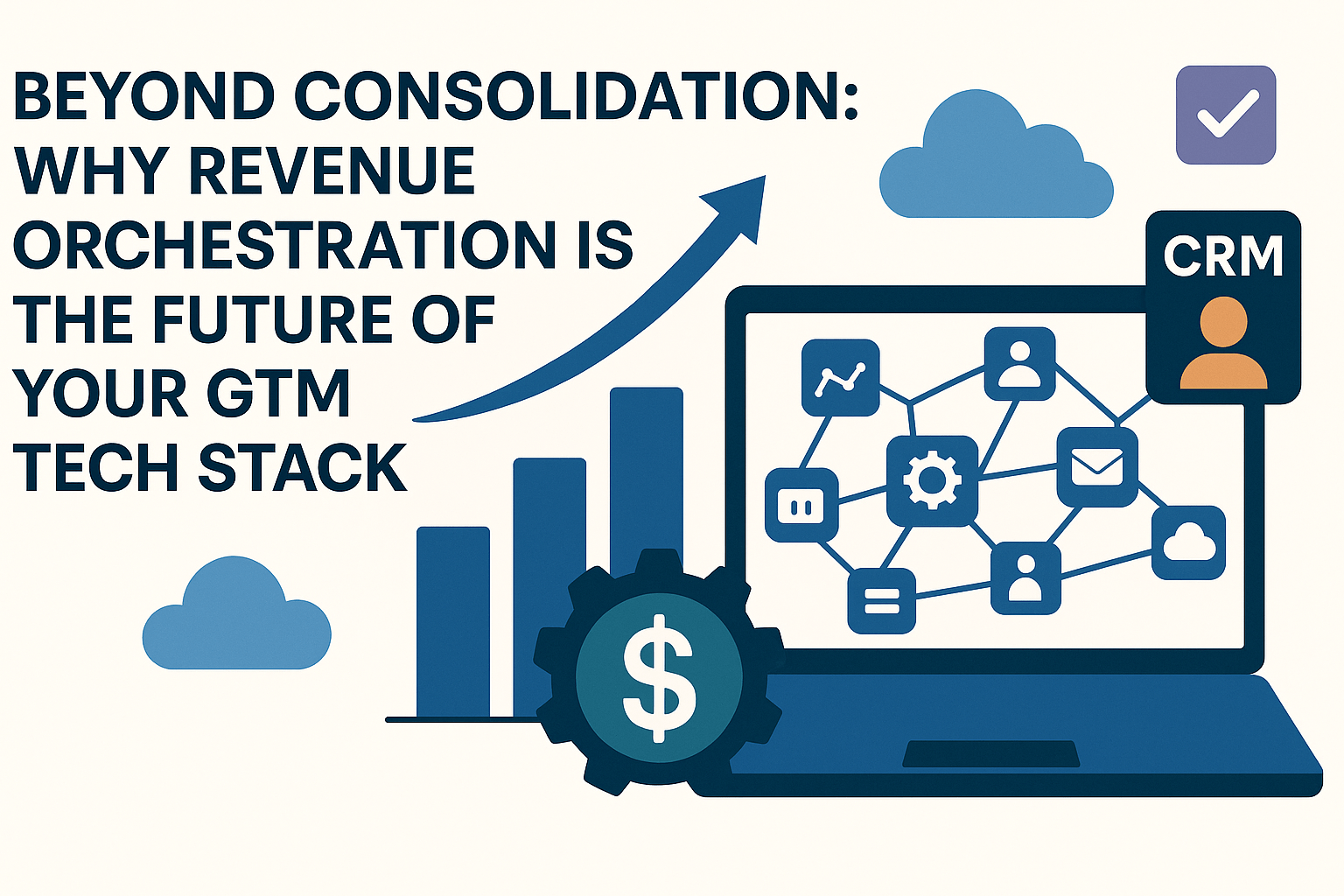TL;DR: Many GTM teams suffer from “tool sprawl”—too many disconnected apps leading to wasted time, lost productivity, and stalled revenue. While tech stack consolidation helps reduce costs, it doesn’t fix fragmented processes or data silos. The true solution is Revenue Orchestration: aligning all GTM tools, data, and workflows (often via AI-powered platforms like Kixie) to create seamless, intelligent buyer interactions, drive growth, and build a future-proof revenue engine.
What is Revenue Orchestration?
Revenue Orchestration is the discipline of aligning tools, workflows, and data across sales, marketing, and customer success—so every buyer interaction is timely, personalized, and connected.
Unlike simple tech stack consolidation, which focuses on reducing the number of tools, orchestration prioritizes how those tools work together to accelerate revenue. It’s about coordination, not just cleanup.
Why Does Your GTM Tech Stack Need This?
Most revenue teams are drowning in disconnected tools. Sales reps spend only 16% of their day selling. Nearly 65% of their time is lost to context switching, manual admin, or broken handoffs.
Revenue Orchestration solves this by turning fragmented tech into a unified, intelligent system—with automation, integration, and AI-guided next steps built-in.
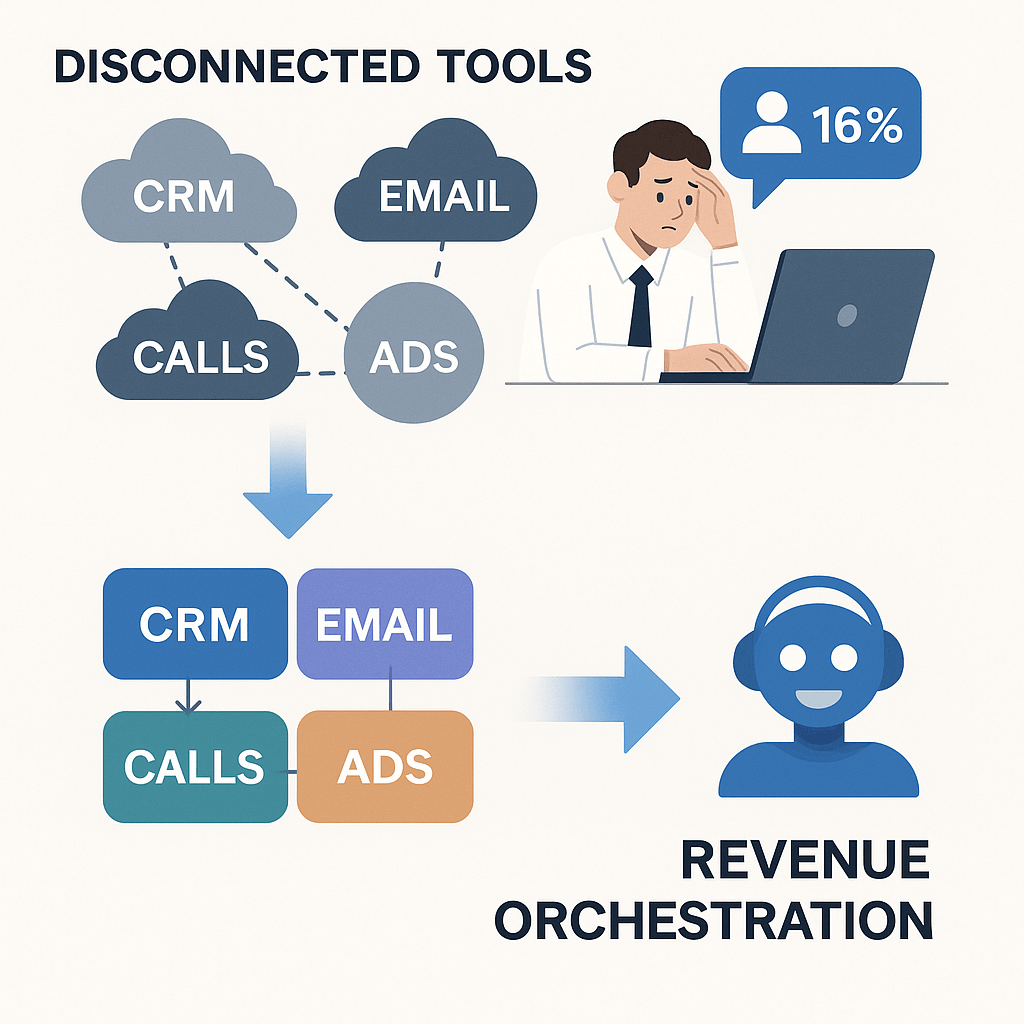
The modern Go-to-Market (GTM) strategy was built on a powerful and alluring promise: technology would make revenue teams faster, smarter, and more efficient. In pursuit of this vision, businesses invested heavily, adopting a suite of specialized tools—Customer Relationship Management (CRM) systems to manage relationships, marketing automation platforms to nurture leads, and sasales engagementools to streamline outreach. Each piece of software was acquired with the best intentions, designed to solve a specific problem and optimize a particular stage of the customer journey.3
Yet, for many organizations, the result has been a stark and frustrating paradox. Instead of seamless efficiency, they found operational friction. The very tools meant to boost productivity have, in aggregate, created a complex web of disconnected systems that actively hinders performance. The data paints a sobering picture: despite massive investments in technology, sales representatives now spend as little as 16% of their workday actively engaging with customers. A staggering 65% of their time is consumed by non-selling activities, with one report finding that 82% of employees lose up to an hour every single day just managing their various applications.
This report charts the course from this state of “tool sprawl” to a more intelligent and profitable future. We will explore how the GTM tech landscape became so bloated, quantify the staggering hidden costs of this complexity, and examine the market’s first, logical reaction: tech stack consolidation. Crucially, this analysis will argue that consolidation, while a necessary cleansing step, is merely a stepping stone. The true, strategic solution—the one that moves beyond reactive cost-cutting to proactive revenue generation—is Revenue Orchestration. The core problem was never the individual tools themselves, but the operational and data-filled gaps between them. The pain lives in the “swivel-chair” integrations and manual data entry required to bridge these gaps, and it is this fundamental disconnect that orchestration is designed to solve.
From Boom to Bloat: How the GTM Tech Stack Exploded
The current state of tech stack complexity was not an accident; it was the result of a perfect storm of innovation, accessibility, and unbridled ambition. To understand the path forward, one must first appreciate the historical forces that led to this “Cambrian explosion” of GTM software.
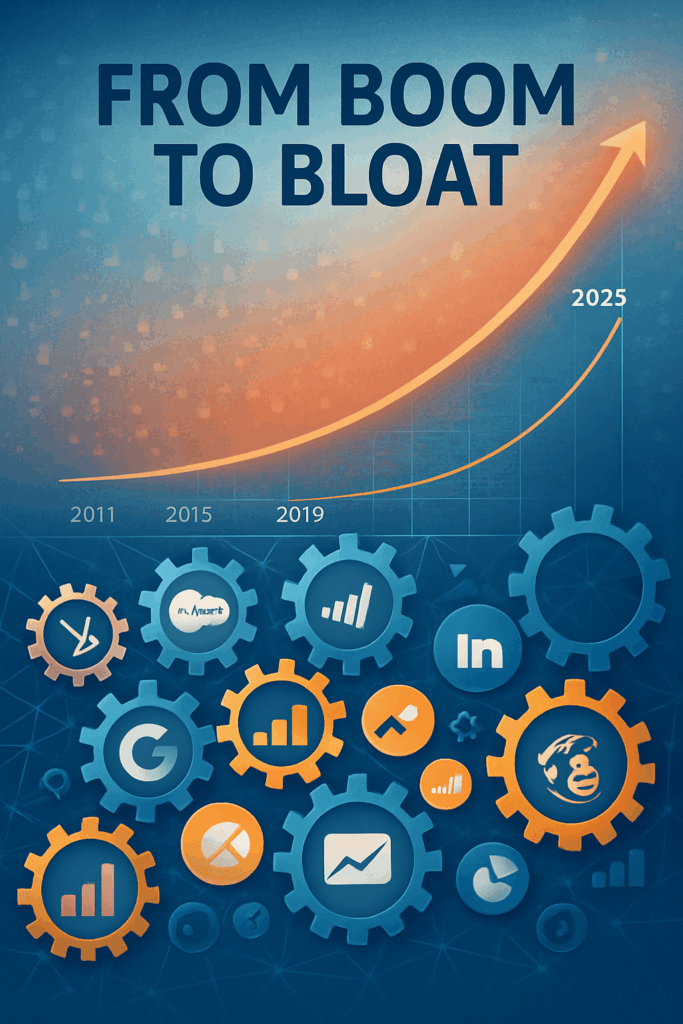
The growth has been nothing short of exponential. In 2011, the now-iconic Chief Martec “Supergraphic” landscape identified approximately 150 marketing technology solutions. By 2025, that number has ballooned by over 100 times to an astonishing 15,384 distinct tools. This represents a 9% increase from 2024 alone, a sign of continued expansion even as the market simultaneously sees older tools consolidate or disappear.
Several key drivers fueled this explosion:
The SaaS Revolution: The widespread shift to the Software-as-a-Service (SaaS) model dramatically lowered the barrier to entry for both vendors and customers. For businesses, it became easy and relatively inexpensive to adopt specialized point solutions to address niche problems, paying via subscription instead of making large, upfront capital investments.

The Rise of AI: More recently, the surge in generative AI has acted as a massive accelerant. It has made building new software easier and cheaper than ever, leading to a wave of AI-native startups targeting specific GTM functions, especially in content creation and sales engagement. Forrester research highlights that AI is rapidly evolving from simple “copilots” that assist sellers to autonomous “agents” that can accomplish parts of a seller’s job, a trend that promises to fuel even more tool creation.
The “Hypertail” of Customization: Beyond commercially available software, the growth of low-code and no-code platforms has empowered a new class of “citizen developers” within marketing and operations teams. These individuals can now build a massive number of bespoke internal tools, custom workflows, and one-off automations, adding a deep and often invisible layer of complexity to the corporate tech ecosystem.
This evolution signifies a critical shift in the nature of fragmentation. The initial MarTech boom was characterized by the adoption of large, monolithic platforms like CRMs and marketing automation systems. The current boom, however, is defined by this “hypertail”—a vast and growing number of smaller, more granular, and often interconnected micro-applications and automations. While the number of vendors continues to climb, the number of custom software programs is likely growing exponentially. This means the problem of fragmentation is not just getting bigger; it is becoming more intricate and decentralized. A strategy based on simply “choosing fewer vendors” is no longer sufficient to manage a problem that now exists at the level of individual workflows and custom-built bots. This new, hyper-fragmented reality demands a system-level, process-oriented solution capable of managing and coordinating this complexity.
The Hidden Costs of Complexity
What are the hidden costs of GTM tool sprawl?
Disconnected tech stacks don’t just waste money—they bleed productivity, wreck data, and slow growth. Here’s what your team might be experiencing:
- Sales fatigue: 71% of reps feel overwhelmed by their tools. Most use 10–13 platforms daily.
- Productivity loss: Up to 40% of a rep’s time is lost to context switching and admin work.
- Wasted spend: One-third of software budgets are wasted—often on tools that no one uses.
- Data silos: 68% of teams cite fragmented data as their top barrier to decision-making.
- Revenue leakage: Sales orgs with >12 tools miss quotas 35% more often than leaner teams.
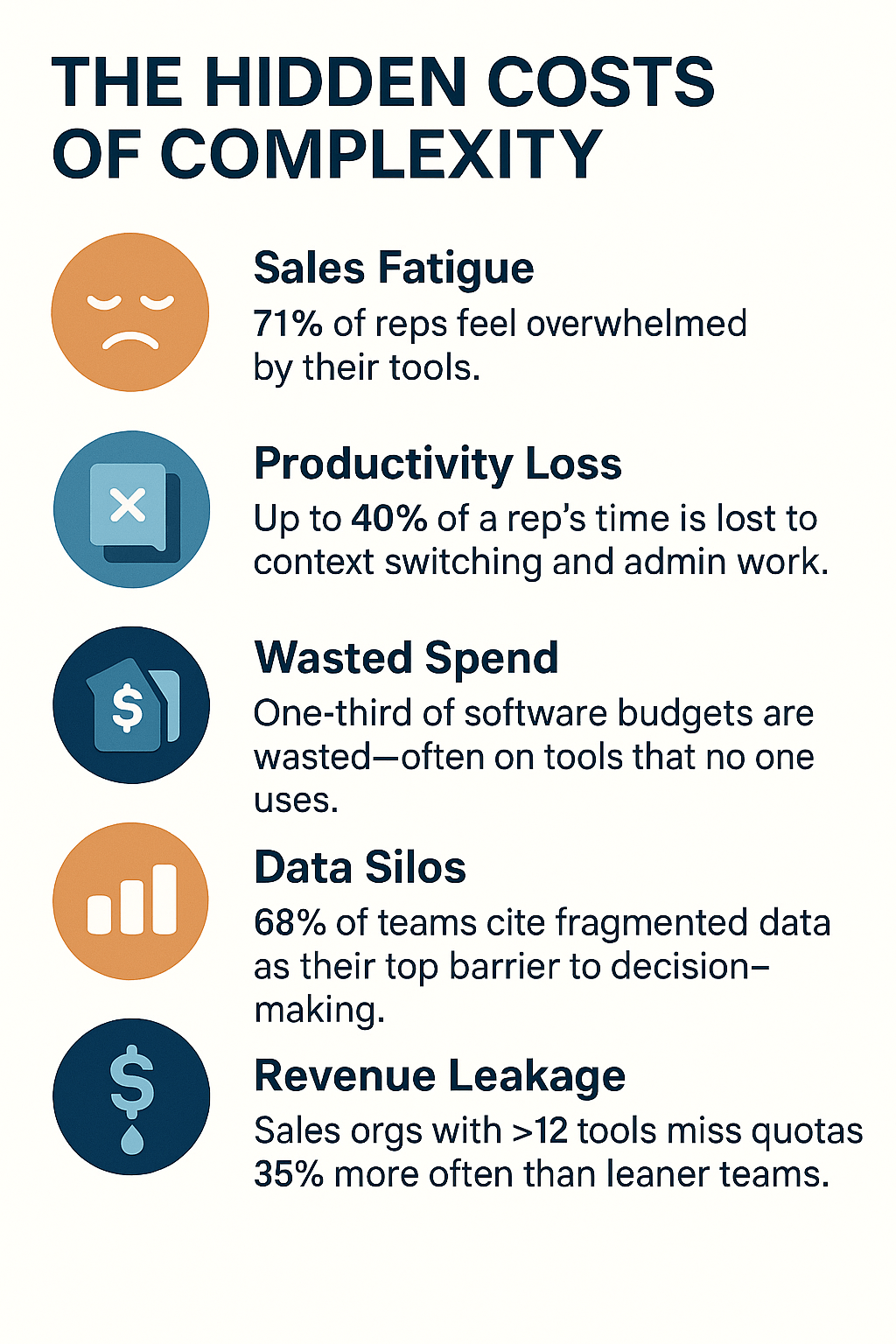
Tool sprawl is far more than an IT headache or an accounting nuisance. It is a systemic plague on the entire revenue engine, inflicting deep and measurable damage on team productivity, financial health, data integrity, and ultimately, the ability to grow revenue. The costs are not just line items on an expense report; they are hidden in wasted hours, missed opportunities, and employee burnout.
The Productivity Collapse
The primary promise of technology—to make people more productive—has been inverted by tool sprawl. Instead of empowerment, teams face a daily battle against complexity.
The Overwhelm Factor: A staggering 71% of sales reps report feeling overwhelmed by the number of tools they are expected to use daily. With the average sales team juggling between 10 and 13 different applications to do their job, this creates immense cognitive overload, leading to decision fatigue and costly errors.
The Context-Switching Tax: The simple act of toggling between applications has a profound cost. Research has shown that this constant context switching can consume up to 40% of a person’s productive time. On average, sales reps spend 18% of their day—nearly 90 minutes—just navigating between different platforms.
The Administrative Burden: The result is a workforce buried in busywork. Analysis reveals that sales reps now spend two full days per week on administrative tasks rather than on the core function of selling.

The Financial Drain
The inefficiency of tool sprawl translates directly into wasted capital and a negative return on technology investment.
Wasted Spend: Research into IT asset management reveals that approximately one-third of all IT spend is wasted. This waste manifests in multiple ways: up to 18% of a company’s software spending goes toward redundant tools with overlapping functionality, and more than half of all licensed SaaS seats sit completely unused for over a year.
The Illusion of Productivity: The correlation between investment and outcome has broken down. Companies with more than 10 tools in their sales stack actually report 22% lower productivity than those with simpler stacks. This creates a negative ROI where adding more tools leads to worse results, a phenomenon known as “tech bloat”.
Data Disarray and The Trust Deficit
Perhaps the most insidious cost of tool sprawl is the corrosion of a company’s most valuable asset: its data.
Pervasive Data Silos: When every tool is its own island, data becomes trapped. 68% of organizations now cite these data silos as their number one data management concern. This fragmentation makes a unified view of the customer journey impossible.
Decisions on Stale Data: The consequences are dire. An alarming 82% of companies admit to making critical business decisions using stale, incomplete, or inaccurate information. With over half of CRM managers admitting their data accuracy is below 80%, trust in the entire GTM system erodes.
The Customer Experience Breakdown: This internal chaos inevitably spills outward, impacting customers. 73% of customers report feeling frustrated when their experience is not consistent across departments. A fragmented data landscape is the root cause of these disjointed experiences, which actively damage brand loyalty.

The Bottom Line: Revenue Leakage and Stalled Growth
The operational friction and data chaos have a direct and devastating impact on top-line revenue and growth.
As the data clearly shows, complexity kills quota attainment. Sales organizations with fewer than seven tools outperform those with more than twelve by 35% in achieving their quotas. Reps forced to operate in highly complex tech stacks are 2.3 times more likely to miss their sales targets. The frustration is so palpable that it fuels turnover; teams with more than 15 tools experience a 40% higher rep attrition rate. This operational chaos leads to direct revenue leakage, which MGI research estimates is experienced by 42% of companies, with EY quantifying the loss at 1-5% of realized EBITA annually.
The First Response: Why We Rushed to Consolidate Our Stacks
Faced with the spiraling costs and operational chaos of tool sprawl, the market’s first collective response was both logical and necessary: tech stack consolidation. This movement represented a defensive strategy designed to regain control, stanch the financial bleeding, and bring a semblance of order to the technological wild west.
Tech stack consolidation is formally defined as the process of simplifying an organization’s technology infrastructure by reducing the number of software tools and platforms in use. This involves a strategic audit to identify and eliminate redundant or overlapping technologies, integrate essential platforms, and move toward a more centralized system.
The primary drivers behind this rush to consolidate were clear and compelling:
- Cost Reduction: This was, and remains, the number one motivation. The goal is to eliminate redundant subscription fees, reduce the IT burden of maintaining dozens of vendor relationships, and allocate budget more strategically. As economic pressures mounted, this became a C-suite mandate, with a 2024 report showing that 53% of companies were actively pursuing consolidation initiatives.
- Improved Operational Efficiency: Beyond cost, companies sought to reduce the complexity that was crippling their teams. By standardizing on fewer platforms, they aimed to create a less fragmented and more intuitive user experience for employees, thereby boosting productivity.
- Bolstered Security: From a risk management perspective, a sprawling tech stack represents a massive and porous attack surface. Each new tool introduces new vulnerabilities and data storage points. Consolidation promised a more secure environment that was easier for IT teams to monitor and protect.
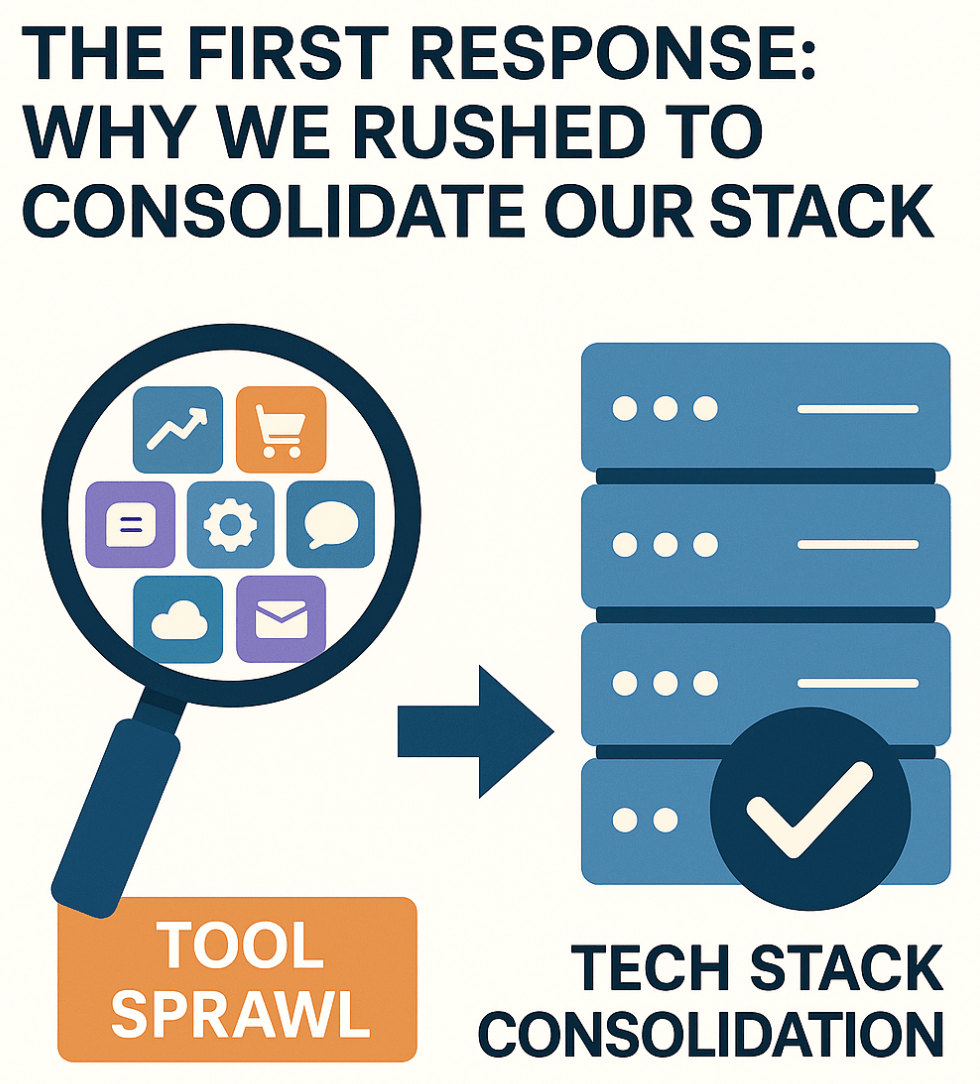
The typical consolidation plan follows a straightforward project management approach: audit the current stack to understand usage and cost, categorize tools to identify redundancies, gather feedback from stakeholders on which tools are most critical, and then execute a phased plan to decommission some tools while expanding the use of others.
However, the very language used to describe this process—”eliminating,” “reducing,” “slashing”—reveals its fundamental nature. Consolidation is a strategy of scarcity, not of growth. It is a tactical, defensive maneuver focused on plugging leaks in the boat rather than building a faster engine. While essential for fiscal hygiene, particularly in tight economic climates, this mindset is inherently limited. It focuses on fixing the symptoms of tool sprawl, such as high costs and too many logins, but it does not address the underlying disease: disconnected business processes and fragmented data flows that stifle revenue growth.
The Consolidation Ceiling: When Fewer Tools Isn’t the Final Answer
While tech stack consolidation provides immediate and often necessary relief, organizations that stop there soon hit a hard ceiling. It can clean up the tech inventory and trim the budget, but it cannot, by itself, create the high-performing, aligned, and agile revenue engine required to win in today’s market. Consolidation is a necessary, but ultimately insufficient, step for several critical reasons.
Limitation 1: It’s Cost-Focused, Not Revenue-Focused
The primary objective of consolidation is to save money. Its success is measured by reduced license fees and a smaller number of vendors. This focus, while important, is fundamentally different from a focus on growing revenue. An obsession with short-term, easily measurable ROI can lead companies to cut tools that, while perhaps underutilized, are critical for long-term strategic initiatives. The conversation revolves around the technology itself—what to keep, what to cut—rather than the end-to-end buyer journey or the optimization of the revenue process.
Limitation 2: It Doesn’t Inherently Fix Broken Processes
Simply removing a tool does not magically repair the fragmented workflow that existed around it. A company can consolidate from three different point solutions to one “all-in-one” platform, but if the handoffs between the marketing, sales, and customer success teams are still manual, undefined, and reliant on email and spreadsheets, the core problem persists. Data silos and inconsistent customer experiences will continue to plague the organization because the underlying process—the way people work together—has not been addressed. The goal should not be just to have tools that integrate with a central CRM, but to have the processes connecting those tools automated and intelligent.
Limitation 3: It Can Create New, Unintended Problems
The cure of consolidation can sometimes introduce its own ailments. Forcing all teams onto a single “mega-platform” may solve the “too many vendors” problem but can create a “jack of all trades, master of none” scenario. This can lead to new limitations in functionality, performance, and interoperability, as the consolidated platform may not be best-in-class for every required function. Furthermore, the cost, time, and change management effort required to migrate off multiple systems and implement a new, consolidated one can be immense, potentially negating the anticipated savings and disrupting the business for months or even years.
These limitations reveal a crucial truth: the number of tools in a stack is a red herring. The real issue is the lack of intelligent, automated communication between the tools. The ultimate goal is not a smaller stack, but a smarter stack. The strategic question must evolve from “What tools do we cut?” to “How do our best-in-class tools work together as a single, cohesive system?” This reframing defines the problem that consolidation leaves unsolved and creates a clear, urgent need for a new paradigm—one focused on orchestrating processes, data flows, and intelligent automation across the entire GTM ecosystem.
The Necessary Evolution: Enter Revenue Orchestration
What is Revenue Orchestration and how is it different from consolidation?
Revenue Orchestration is a system-level approach to coordinating your GTM tech stack. It connects sales, marketing, and CS tools into a unified process—automating handoffs, syncing data, and triggering actions across platforms.
Where tech consolidation reduces the number of tools, orchestration increases the impact of your tools by improving how they work together.
Top benefits of Revenue Orchestration:
- Unified, real-time customer data
- Automated, personalized follow-ups
- Faster deal velocity through connected workflows
- Fewer dropped leads and misaligned handoffs
- Predictable pipeline growth powered by AI
Revenue Orchestration is the strategic successor to consolidation. It represents a fundamental shift in thinking, moving beyond a narrow focus on the tools themselves to a holistic focus on the alignment of technology, processes, and people across the entire revenue lifecycle. It is not about having fewer tools; it is about making the entire system work in perfect harmony.
Revenue Orchestration is best defined as the discipline of coordinating data, channels, and workflows so that every single buyer interaction is timely, contextual, and value-driven. It is a system that seamlessly aligns the efforts of sales, marketing, and customer success teams by using integrated tools and unified data to automate tasks, track the complete customer journey, and provide actionable insights that lead to better decisions and predictable growth.
Leading industry analysts at Forrester have identified the emergence of Revenue Orchestration Platforms (ROPs) as a “new supergroup” of technology. These platforms combine the capabilities of previously separate categories—sales engagement, conversation intelligence, and rerevenue operationsnto a single, unified system that acts as the “central nervous system of revenue generation.
The strategic difference between the two approaches is profound.
At its core, orchestration is powered by Artificial Intelligence. ROPs leverage AI to analyze data signals from across the entire GTM stack, surface critical insights, and guide sellers on the next best action to take with a specific prospect at a specific time. This moves far beyond simple, linear automation (“if this, then that”) to intelligent, contextual execution that adapts to the buyer’s behavior in real time.
This new paradigm is the only viable strategy for managing the future of GTM technology. As established earlier, the landscape is becoming hyper-fragmented with a “hypertail” of countless micro-apps, custom workflows, and AI agents. A simple consolidation strategy is ill-equipped to manage this level of granular complexity. Orchestration, however, is designed for this very environment. It does not necessarily seek to eliminate all point solutions; rather, it provides an intelligent framework to govern them. By focusing on the data flows and the trigger-action sequences between these disparate tools, orchestration tames the chaos and makes the entire GTM ecosystem—no matter how complex—work in concert toward a single goal: revenue.
Orchestration in Action: From Disconnected Tools to Intelligent Plays
Theory is valuable, but action is what drives results. To demystify the concept of “orchestration,” it is essential to see how it works in practice. An orchestrated GTM motion is built on “plays”—automated, multi-step, cross-platform workflows that are triggered by specific buyer signals.
A Revenue Orchestration Platform (ROP) acts as the “brain” or “command center” of this system. It constantly listens for signals from across the tech stack—a form submission in HubSpot, a high-value page view on your website, a support ticket logged in Zendesk, or a change in a deal stage in Salesforce. The ROP’s logic then decides what to do next.
But a brain needs a body to execute its commands. This is the critical role of an execution layer. While the ROP provides the intelligence, a platform like Kixie provides the action. With its powerful voice and SMS automation, deep bi-directional CRM integrations, and a webhook-first architecture, Kixie serves as the indispensable communication engine that brings orchestrated plays to life, turning digital signals into real-time human conversations.
Consider these real-world orchestration plays:
1. The Inbound “Speed-to-Lead” Play
Signal: A high-intent prospect submits a “Request a Demo” form on the company website. This lead data is instantly captured in a CRM like HubSpot or Salesforce.
Orchestration Logic: The ROP immediately identifies this as a “hot lead” that requires an immediate, high-touch response.
Kixie’s Execution:
- Instantly: The ROP triggers Kixie via integration. Kixie initiates an automated call to the lead from the assigned sales rep. The call is placed using ConnectionBoost™ AI Local Presence, which automatically displays a local number on the prospect’s caller ID, increasing pickup rates by up to 500%.
- If No Answer: The moment the call goes to voicemail, Kixie’s system automatically drops a pre-recorded, personalized voicemail from the rep and simultaneously sends a templated SMS message: “Hi [Prospect Name], it’s from [Company]. I just saw you requested a demo. Is now a good time to connect for a minute?”.
- Simultaneously: The lead is automatically added to that specific rep’s Kixie PowerDialer list, guaranteeing a follow-up call is attempted later that day without the rep having to remember or manually schedule it.
- Feedback Loop: Once the call is completed (or missed), the outcome—including the call disposition, a link to the call recording, and an AI-generated call summary—is automatically logged back into the contact’s activity timeline in the CRM. This new data point becomes the next signal, informing the subsequent step in the orchestration sequence.
2. The “Stalled Deal” Rescue Play
Signal: A high-value deal in the CRM (e.g., Pipedrive) has had no new outbound activity logged for 10 consecutive days.
Orchestration Logic: The ROP flags this deal as “at-risk” of going cold.
Kixie’s Execution:
- An automated, multi-day SMS cadence is triggered via Kixie to re-engage the prospect with a soft, non-intrusive touchpoint.
- Simultaneously, a high-priority task is created for the Account Executive in their workflow, and the primary contact for the deal is added to a special “priority call queue” in their Kixie PowerCall dialer.
- The system can even leverage Conversation Intelligence data from past Kixie calls to surface key topics or pain points that the rep can use to craft a more relevant and compelling script for their next outreach call.
The key to this level of advanced, flexible automation is Kixie’s webhook-first architecture. Every significant event within the Kixie platform—a call is initiated, a call is answered, an SMS is sent, a disposition is logged—can emit a real-time webhook. This allows Kixie to seamlessly act as either the trigger or the action in any workflow imaginable, whether it’s built in a dedicated ROP or through an integration platform like Zapier or Make. This turns the communication platform from a simple tool into a dynamic, integrated component of a sophisticated revenue engine.
Conclusion: Building a Future-Proof Revenue Engine
The journey of Go-to-Market technology has been one of rapid, and often chaotic, evolution. We moved from entirely manual processes to a deluge of specialized tools, each promising a piece of the efficiency puzzle. We reacted to the resulting complexity with consolidation, a necessary but ultimately limited strategy focused on cleaning up the past rather than architecting the future. Today, we stand at the precipice of the next great evolution.
The evidence is clear: tool sprawl created a crisis of productivity, cost, and data fragmentation that actively harmed revenue generation. Consolidation addressed the most obvious symptoms but left the underlying disease of process fragmentation untreated. Revenue Orchestration is the strategic imperative for 2025 and beyond because it is the only approach that directly targets this root cause. It is a proactive, revenue-focused discipline that intelligently aligns people, processes, and technology across the entire customer lifecycle.
The future of sales is data-driven, digital, and dynamic. Gartner predicts that by 2025, 80% of all B2B sales interactions will occur in digital channels, and the most successful organizations will be those that have fully transitioned to data-driven selling. This future is simply impossible to achieve with a disconnected or merely consolidated tech stack. An orchestrated revenue engine is not just more efficient; it is more intelligent, more agile, and more resilient to market shifts.
Building this engine requires a strategic “brain”—the Revenue Orchestration Platform that can ingest signals and determine the next best action. But just as importantly, it requires a powerful execution layer that can turn those insights into action and data points into human conversations. Kixie provides that critical communication and automation layer, serving as the voice and messaging engine that powers the modern, orchestrated GTM strategy. By connecting signals to conversations and conversations to conversions, businesses can finally deliver on the original promise of technology: to be faster, smarter, and more effective in the pursuit of growth.
FAQs: GTM Tech Stacks, Tool Sprawl, and Revenue Orchestration
What is the current state of modern Go-to-Market (GTM) tech stacks?
The modern GTM strategy initially promised that technology would make revenue teams faster, smarter, and more efficient. However, despite heavy investments in specialized tools like Customer Relationship Management (CRM) systems, marketing automation platforms, and sales engagement tools, the result has often been a “stark and frustrating paradox” of operational friction. Instead of seamless efficiency, businesses face a complex web of disconnected systems that actively hinder performance. This situation is widely referred to as “tool sprawl”. Sales representatives, for example, spend as little as 16% of their workday actively engaging with customers, with nearly 65% of their time consumed by non-selling activities, including managing various applications. The core problem isn’t the individual tools but the “operational and data-filled gaps between them”.
How did GTM tech stacks become so complex?
The current complexity of tech stacks was not accidental but resulted from a “perfect storm of innovation, accessibility, and unbridled ambition,” leading to a “Cambrian explosion” of GTM software. Key drivers include:
- The SaaS Revolution: The widespread shift to the Software-as-a-Service (SaaS) model significantly lowered the barrier to entry for both vendors and customers, making it easy and relatively inexpensive to adopt specialized “point solutions” for niche problems via subscription.
- The Rise of AI: The surge in generative AI has made building new software easier and cheaper, leading to a wave of AI-native startups targeting specific GTM functions, especially in content creation and sales engagement. Forrester research indicates AI is evolving from “copilots” to autonomous “agents,” which will fuel even more tool creation.
- The “Hypertail” of Customization: The growth of low-code and no-code platforms has empowered “citizen developers” within marketing and operations teams to build a massive number of bespoke internal tools, custom workflows, and one-off automations, adding a deep and often invisible layer of complexity. This evolution has shifted fragmentation from large monolithic platforms to a “hypertail” of smaller, more granular, and often interconnected micro-applications and automations, making the problem “more intricate and decentralized”.
What are the hidden costs of GTM tool sprawl?
Disconnected tech stacks do more than just waste money; they “bleed productivity, wreck data, and slow growth”. The costs are hidden in wasted hours, missed opportunities, and employee burnout.
- Productivity Collapse:
- Sales Fatigue: 71% of sales reps feel overwhelmed by the 10-13 platforms they typically use daily, leading to cognitive overload.
- Context-Switching Tax: Constant toggling between applications consumes up to 40% of a person’s productive time, with sales reps spending nearly 90 minutes daily just navigating platforms.
- Administrative Burden: Sales reps spend two full days per week on administrative tasks rather than selling.
- Financial Drain:
- Wasted Spend: Approximately one-third of all IT spend is wasted, with up to 18% on redundant tools and over half of licensed SaaS seats unused for over a year.
- Illusion of Productivity: Companies with more than 10 sales tools actually report 22% lower productivity than those with simpler stacks, indicating “tech bloat”.
- Data Disarray and Trust Deficit:
- Pervasive Data Silos: 68% of organizations cite data silos as their top data management concern, making a unified customer view impossible.
- Decisions on Stale Data: 82% of companies admit to making critical business decisions using stale, incomplete, or inaccurate information, eroding trust.
- Customer Experience Breakdown: Internal chaos leads to inconsistent customer experiences, frustrating 73% of customers and damaging brand loyalty.
- Revenue Leakage and Stalled Growth:
- Sales organizations with fewer than seven tools outperform those with more than twelve by 35% in achieving quotas.
- Teams with more than 15 tools experience a 40% higher rep attrition rate.
- Revenue leakage is estimated to affect 42% of companies, costing 1-5% of realized EBITA annually.
What is tech stack consolidation?
Tech stack consolidation is the process of simplifying an organization’s technology infrastructure by reducing the number of software tools and platforms in use. This involves auditing, identifying and eliminating redundant technologies, integrating essential platforms, and moving toward a more centralized system. The primary drivers for consolidation include:
- Cost Reduction: The number one motivation is to eliminate redundant subscription fees and reduce IT burden; 53% of companies were actively pursuing consolidation in 2024.
- Improved Operational Efficiency: To reduce complexity and create a less fragmented user experience for employees.
- Bolstered Security: To reduce the “massive and porous attack surface” that a sprawling tech stack creates. Consolidation is described as a “strategy of scarcity,” a “tactical, defensive maneuver focused on plugging leaks in the boat rather than building a faster engine”. While necessary for fiscal hygiene, it primarily addresses symptoms like high costs, not the underlying problem of disconnected business processes and fragmented data flows that stifle revenue growth.
What are the limitations of tech stack consolidation?
While consolidation provides immediate and necessary relief, organizations that stop there “soon hit a hard ceiling” because it is ultimately an insufficient step.
- Cost-Focused, Not Revenue-Focused: Its primary objective is to save money, measured by reduced license fees, which is fundamentally different from growing revenue. This focus can lead to cutting tools critical for long-term strategic initiatives.
- Doesn’t Inherently Fix Broken Processes: Simply removing a tool does not magically repair fragmented workflows. If handoffs between teams remain manual and undefined, data silos and inconsistent customer experiences will persist. The goal should be automated and intelligent processes connecting tools, not just tool integration.
- Can Create New, Unintended Problems: Forcing all teams onto a single “mega-platform” may solve the “too many vendors” problem but can create a “jack of all trades, master of none” scenario, leading to new limitations in functionality or performance. The immense cost, time, and change management effort for migration can also negate anticipated savings. These limitations reveal that the number of tools in a stack is a “red herring”; the real issue is the lack of intelligent, automated communication between them. The strategic question should evolve from “What tools do we cut?” to “How do our best-in-class tools work together as a single, cohesive system?”.
How is Revenue Orchestration different from consolidation?
Revenue Orchestration is the “strategic successor” to consolidation, representing a “fundamental shift in thinking”.
- Consolidation is a tactical, defensive maneuver focused on reducing the number of tools and cutting costs. It addresses the symptoms of tool sprawl but leaves the underlying problem of “disconnected business processes and fragmented data flows” untreated.
- Revenue Orchestration is a proactive, revenue-focused discipline that intelligently aligns people, processes, and technology across the entire customer lifecycle. It’s not about having fewer tools, but about making the entire system work in perfect harmony, increasing the impact of existing tools by improving how they work together. It is designed to manage the future “hyper-fragmented” GTM landscape by providing an intelligent framework to govern disparate tools, focusing on data flows and trigger-action sequences.
What are the top benefits of Revenue Orchestration?
Revenue Orchestration transforms fragmented tech into a unified, intelligent system. Top benefits include:
- Unified, real-time customer data.
- Automated, personalized follow-ups.
- Faster deal velocity through connected workflows.
- Fewer dropped leads and misaligned handoffs.
- Predictable pipeline growth powered by AI.
An orchestrated revenue engine is not just more efficient; it is also more intelligent, more agile, and more resilient to market shifts.
How does Revenue Orchestration work in practice?
An orchestrated GTM motion is built on “plays”—automated, multi-step, cross-platform workflows triggered by specific buyer signals.
- A Revenue Orchestration Platform (ROP) acts as the “brain” or “command center”. It constantly listens for signals from across the tech stack (e.g., a form submission, a high-value page view, a support ticket, or a change in deal stage) and then decides “what to do next”.
- An execution layer is needed to carry out the ROP’s commands. For instance, a platform like Kixie provides this action, serving as the “indispensable communication engine that brings orchestrated plays to life,” transforming digital signals into real-time human conversations. Kixie’s webhook-first architecture allows it to seamlessly act as either the trigger or the action in any workflow.
- Real-world examples of orchestration plays include:
- The Inbound “Speed-to-Lead” Play: When a high-intent prospect submits a “Request a Demo” form (signal), the ROP immediately identifies it as a “hot lead”. The ROP then triggers Kixie to initiate an automated call to the lead from the assigned sales rep, using ConnectionBoost™ AI Local Presence to display a local number and increase pickup rates by up to 500%. If there’s no answer, Kixie automatically drops a pre-recorded, personalized voicemail and sends a templated SMS. The lead is also added to the rep’s Kixie PowerDialer list for guaranteed follow-up. The call outcome, recording, and AI-generated summary are then logged back into the CRM, informing subsequent steps.
- The “Stalled Deal” Rescue Play: If a high-value deal in the CRM has no new outbound activity for 10 consecutive days (signal), the ROP flags it as “at-risk”. Kixie then triggers an automated, multi-day SMS cadence to re-engage the prospect. Simultaneously, a high-priority task is created for the Account Executive, and the primary contact is added to a “priority call queue” in their Kixie PowerCall dialer. The system can even leverage Conversation Intelligence data from past calls to help the rep craft a more relevant script for outreach.
Ready to transform your GTM strategy?


